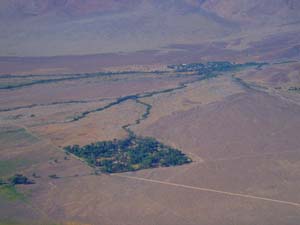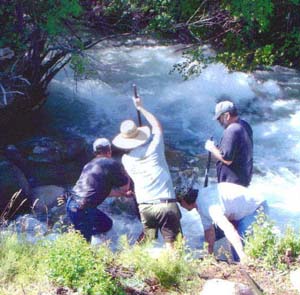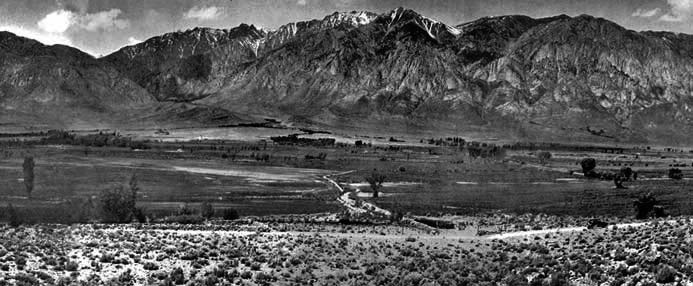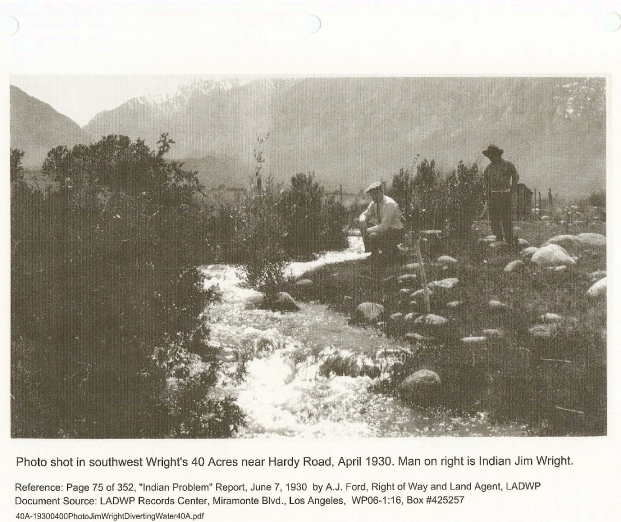Owens Valley 40 Acres Community Continues to Fight LAWDP for Water
The purpose of this website is to provide some background into the history of 40 Acres and our ongoing water dispute with the Los Angeles Department of Water and Power (LADWP) over surface water that flows through our community. This dispute began in 2001, when LADWP, for the first time in history, began to reduce the amount of water that flowed through our ditches. Up until 2001, dating all the way back to the time when the first drop of water was taken from the Owens Valley by William Mulholland,no employee of LADWP has ever meddled with the water flows in our ditches. But first a bit of history.
 "40 Acres" is a term coined to describe a small neighborhood of private property located in the Eastern Sierra about 12 miles outside of the town of Bishop California. The size of the neighborhood is 40 acres, and it is located in Round Valley, where the desert meets the mountains, at the bottom of Sherwin Grade, about 2 miles west of hwy 395. Our neighborhood is bordered by LADWP land on three sides and Bureau of Land Management (BLM) land on the west side.
"40 Acres" is a term coined to describe a small neighborhood of private property located in the Eastern Sierra about 12 miles outside of the town of Bishop California. The size of the neighborhood is 40 acres, and it is located in Round Valley, where the desert meets the mountains, at the bottom of Sherwin Grade, about 2 miles west of hwy 395. Our neighborhood is bordered by LADWP land on three sides and Bureau of Land Management (BLM) land on the west side.
This 40 acre parcel is subdivided into 49 different lots of varying sizes, most of which are owned by families and individuals that live here year round. A ditch system that splits off of Pine Creek delivers water all year round to almost all of the lots, and has for a long time as you will see.
In 1890, a Native American Paiute Indian named Jack Wright filed the papers in Inyo Co. proving up his homestead claim to 80 acres of desert land in Round Valley. He started a sheep ranching operation, a fruit orchard and pasture. As part of developing that operation, he dug a ditch and diverted water from Pine Creek for irrigation of his property. Eventually, title of the land passed to a brother, Jim Wright, also a sheep rancher. A photograph taken in 1930 shows Indian Jim Wright and the ditch that comes from Pine Creek. An aerial photo from 1944 shows an irrigated pasture, in sharp contrast to the surrounding barren desert. In 1926, LADWP acquired the ownership of the south 40 acres, while Jim Wright continued to live on and irrigate the north 40 acres — the location of today’s community known by the same name. In the 1930’s Jim Wright began to subdivide and sell smaller parcels of his land. As time went by more lots were sold until the ownership pattern of today came to be. Throughout this period, ditches were modified to share the available water with the new owners. Early residents of the community relied on Pine Creek water for domestic use as well as livestock production, pasture irrigation, and fire protection. Today, residents of 40 Acres continue the tradition started in the 1800’s of putting water to beneficial uses which include: domestic supply, agricultural supply, fire protection, ground water re-charge, fresh water replenishment, water recreation, and cold freshwater habitat. As you can see by the picture, 40 Acres is a green oasis in the midst of a desert landscape.
Since the 1890’s, the residents of 40 acres have continuously taken care of the water needs of the community. They have cleaned and maintained the conveyance and ditch system, and they have regulated the flow of water year by year and season by season to guard against flooding during high runoff times and to ensure the equitable sharing of water during the dry times. During all that time (111 years) the LADWP made no effort to control or otherwise restrict the flow.
community. They have cleaned and maintained the conveyance and ditch system, and they have regulated the flow of water year by year and season by season to guard against flooding during high runoff times and to ensure the equitable sharing of water during the dry times. During all that time (111 years) the LADWP made no effort to control or otherwise restrict the flow.
Things changed in 2001. That year, LADWP destroyed a historic wood control gate that had been used and maintained by 40 Acres residents, and built a new concrete and steel water gate at the point where the 40 Acres ditch diverged. They locked the water gate with a chain and padlock. Immediately LADWP began to use that gate to reduce the water flows to 40 acres by as much as 50%. (Incidentally, the gate was built on public, BLM, land without obtaining a permit). When asked to explain the reason for the reduction, LADWP indicated that we were not entitled to the amount of water we were taking. Yet they were unable to show any evidence to support that claim. When asked to stop restricting our water flow, they refused. After a few days, 40 Acres residents cut the chain on the new steel gate, and installed their own lock next to the LADWP lock. This allowed 40 Acres property owners to maintain control over the water flows in their ditch system. After some low-level skirmishing, a quasi-truce prevailed. The chain on the gate at that time had two locks, one for LADWP and one for 40 Acres. LADWP turned down the water and we turned it back up on a daily basis. This remained the state of affairs until 2013.
Shortly after the 2001 installation of two locks on the gate, the residents of 40 Acres organized by establishing the 40 Acres Homeowners Water Association. The initial purpose of the Association was to provide a group that could represent the interests of 40 Acres in discussion with LADWP. Membership in the Association is voluntary, but all property owners are encouraged to join. Currently over 80% of all property owners are members.
Our demands are few. We want LA to recognize our pre-1914 appropriative water right and to restore the historic flows through the community. LA’s own measurements show a 4 cubic foot per second (CFS) average outflow from 40 Acres over a 30 year period from 1976 through 2005. We want the flow through our community to maintain that measurement. This flow would provide for the actual consumptive use of water within the community and for “carriage flow”, water that is not consumed, but is the delivery mechanism for the consumed water. Incidentally, the 4 CFS of water that leaves 40 Acres goes back into LADWP ditches, for use by the city or by the ranchers who lease grazing land from the city that is downstream from 40 Acres.
The Water Association collected donations and formed a legal fund. That fund was used to hire legal assistance to help us get to the table with the City and hopefully resolve the issue. We were asking that LA respect our rights as a co-water user in the Owens Valley. We wanted them to recognize our pre-1914 water right to the same amount of water that we have continuously and historically used, for over 100 years, without interference by LADWP.
In 2013 LADWP appointed a new Aqueduct Manager. Not long after that, we were invited to meet with LADWP and discuss our issues. LADWP realized that they could deliver more water to LA by running the water thru our neighborhood, rather than around it. That is because all of our ditches have been consistently wet for over 100 years, and consequently the banks are saturated and sealed with silt. An informal handshake agreement was struck, and seasonal water flow levels for our ditch were identified. We removed our lock from their chain.
In the years since, our relationship with LADWP has continued to improve. We no longer need to check the flow level entering our system. LADWP personnel does that on a daily basis. In 2019, LADWP granted us permission to replace our ageing water gate infrastructure located on their property. 40 Acres property owners planned and constructed a water division gate at the top of the neighborhood which dependably divides the flow for our ditch system. LADWP construction crews provided us with crucial equipment and backfill material for that project.
As recently as the spring of 2021, LADWP undertook a major ditch maintenance and improvement project on one of the main ditches upstream from us to allow for more dependable water delivery to our system during spring runoff.
Our relationship with LADWP is better than it has ever been. As drought in the west and California continues to worsen, we are hopeful that what we have cultivated with them will see us through.



